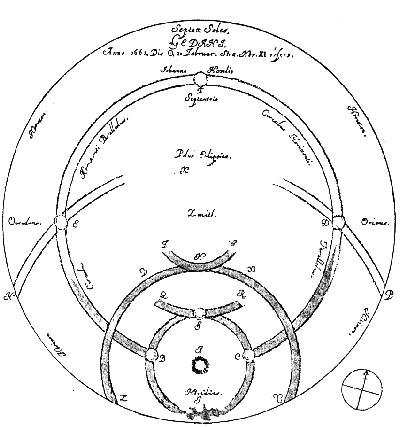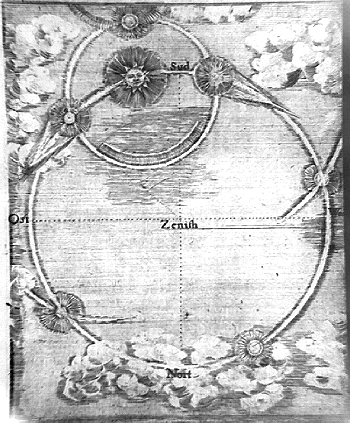The first report on the Danzig halo phenomenon
The Danzig halo phenomenon from February 20, 1661, is probably the most famous halo phenomenon ever and is still vividly discussed today. It was observed by the eminent astronomer Johannes Hevelius, who describes the phenomenon in his book "Mercurius in Sole visus" based on a drawing. A reproduction of the drawing can be found in almost every book about halo phenomena. What is special about this phenomenon is the observation of fragments of a 90° ring around the sun, where parhelia could be seen at its intersections with the horizontal circle. The existence of these types of halos has not yet been proven by compelling photos. There is also no theoretical explanation. Therefore, it has repeatedly been speculated that the 90° ring does not exist and Hevelius' observation was inaccurate, or that the drawing is being misinterpreted. Tape suggests that the 90° ring is actually a sub-sun arc. This view is also shared by Greenler. Hastings argues that a halo phenomenon observed only once in a quarter millennium cannot exist.
While researching old halo depictions, I came across the writing of a pastor from Danzig, with the title: "Sevenfold Solar Miracle, or seven parhelia, which were seen in our sky on February 20, 1661, New Style, around 11 o'clock until after 12 on Sexagesima Sunday." The original is in the Herzog August Library Wolfenbüttel, which provided me with a microfilm copy upon request. The writing was penned by Georg Fehlau, the then pastor of Danzig's St. Mary's Church, and reports in German on the same halo phenomenon that Hevelius also saw in Danzig. The writing recounts a sermon Fehlau delivered at St. Mary's Church on March 6, just 14 days after the halo phenomenon. It delves extensively into the halo phenomenon, "about which the whole city has talked a lot in these 14 days and rightly continues to talk, and will be talked about far away". Fehlau writes that the phenomenon was "seen by more than a thousand eyes". My initial assumption was that it was a parallel observation to Hevelius’ observation, which could solve the riddle of Hevelius' halo.
Unfortunately, this assumption was not confirmed. Fehlau's description of the phenomenon is almost identical to that of Hevelius. I was initially surprised by this, as the book by Hevelius was only published in 1662, almost a year after Fehlau's writing. Fehlau notes in a footnote that the description of the phenomenon is based on Hevelius. According to his own statements, he visited Hevelius on March 3, 1661, to observe a comet together. It is very likely that Hevelius gave Fehlau the records of the halo phenomenon on that occasion. Thus, Hevelius must have documented his observation immediately after the halo phenomenon.
Here I reproduce the description of the phenomenon by Fehlau:
"1. We hereby proceed to the viewing and consideration of our recently appeared side- or companion-suns, which were seen 14 days ago today; about which we are speaking here. With them it was as follows: 14 days ago today was February 20, around 11 a.m. when the sun stood in the south towards the east and the air was quite bright and clear everywhere, seven suns were clearly seen at the same time in the sky, namely three colored and three white besides the real sun. Around them was firstly a quite large almost closed circle, very beautiful with colors, like a rainbow, on which two colored parhelia stood on both sides, at the same height from the horizon with the real sun. Both had long clear and whitish tails pointed like comets, one going to the east, the other to the west.Secondly, right above the suns on this circle, under a vertical line stood a piece of an inverted circle or rainbow, also very beautiful with various colors, in which a somewhat dark parhelion was also present.Thirdly, there also appeared a much larger circle with various beautiful colors around the sun, which surrounded the previous one, was somewhat paler and not completely closed because the horizon was too close, and the diameter of the circle was too large, on which above near the main point likewise an inverted piece of the rainbow could be seen, very bright and beautiful with colors.Fourthly, another exceedingly whitish and silver-colored circle came forth as if from the two parhelia near the real sun, which was found around the entire horizon and stood everywhere equally far away at about 20 degrees: On this circle, there were again three silver-colored suns, one right in the north towards the west, namely opposite the real sun. The other in the north towards the east and the third in the south towards the west. Through these last two as eastern and western, a white piece of circle arc from above came down through, at the same time through the large arc on which they stood. Thus through these two white parhelia a white cross seemed to go, which was very remarkable and wondrous to see for over 1 1/2 hours before everything had passed again. Thus this was an exceedingly beautiful picture, in which 7 suns were seen at the same time, which otherwise has not been observed. Indeed, learned people consider that if one had perhaps observed this image a little earlier, one might have seen 9 suns at the same time."
The types of halos can be easily identified from the text. In the first section, Fehlau describes the 22° ring with both parhelia. In the second section, the upper tangent arc, in the third section the 46° ring with circumzenithal arc and in the fourth section the parhelic circle with anthelion and two parhelia in the 90° area, passing through the fragments of a large ring-shaped halo (Hevel's halo).
When you compare the description with that of Hevelius, there are almost no differences. Even the choice of words and the division of the sections are the same. However, unlike Hevelius's report, the precise angle measurements are missing. Also, Fehlau emphasizes more clearly than Hevel that the 90° halo formed a cross with the parhelic circle. This argues against the assumption that Hevel's halo was the subparhelic arc, as the subparhelic arc intersects the parhelic circle at a shallow angle, which is unlikely to give the impression of a cross. However, since Fehlau's writing is not an independent observation from that of Hevelius, the existence of the 90° ring cannot be clarified.
Very interesting is a drawing on the last page of Fehlau's writing. Fehlau mentions the drawing not at all. Therefore, it cannot be said with certainty whether it really is a representation of the Danzig halo phenomenon, although it is very likely. What is missing is the circumzenithal arc, the 46° ring, and the upper tangent arc. However, the anthelion and the two paraselenae, through which arc segments pass, are depicted. Upon closer inspection, one sees that the paraselena in the northeast is drawn about 110° from the sun and the southwestern paraselena has a distance of 90° from the sun. So were they perhaps not parhelia in the 90° area, but 120° parhelia? Even a trained observer can easily misjudge the distance of the 120° parhelia. Furthermore, the arc that goes through the northeastern paraselena in the drawing bears a great similarity to the subparhelic arc, which at this solar altitude (about 27°) also passes exactly through the 120° parhelion. Although the other arc rises more steeply through the other paraselena, this drawing supports the theory that Hevel's halo was the subparhelic arc and the parhelia seen at the intersection with the parhelic circle were actually 120° parhelia.

